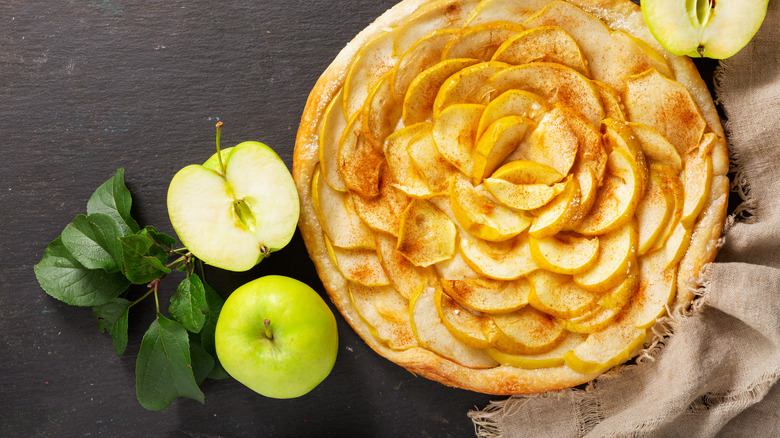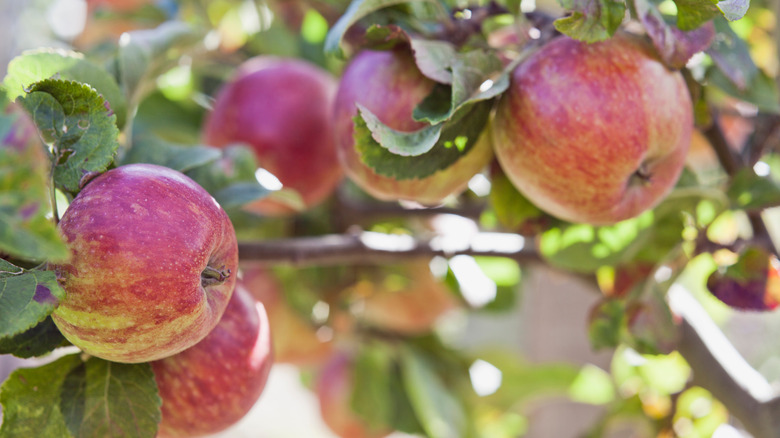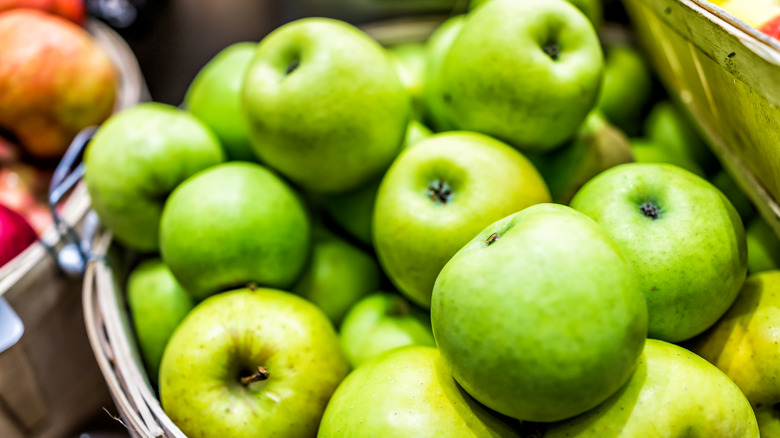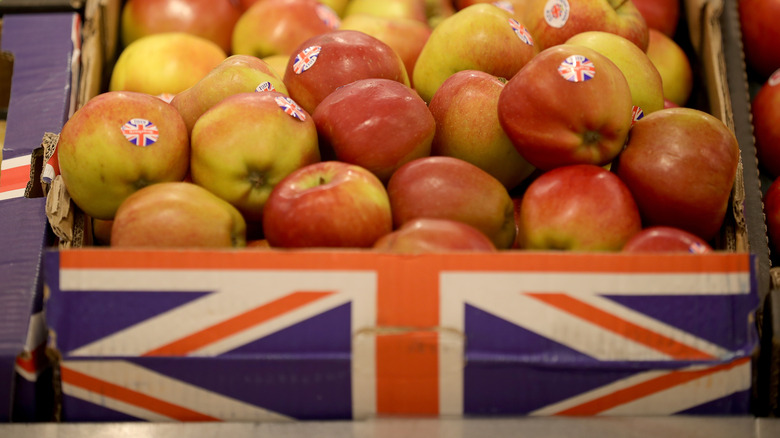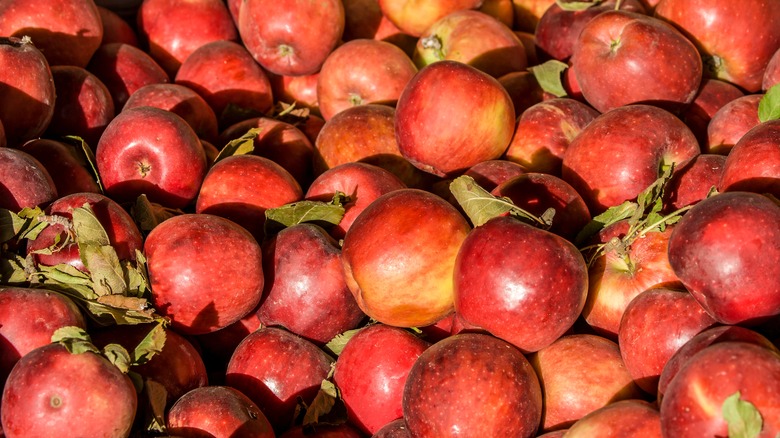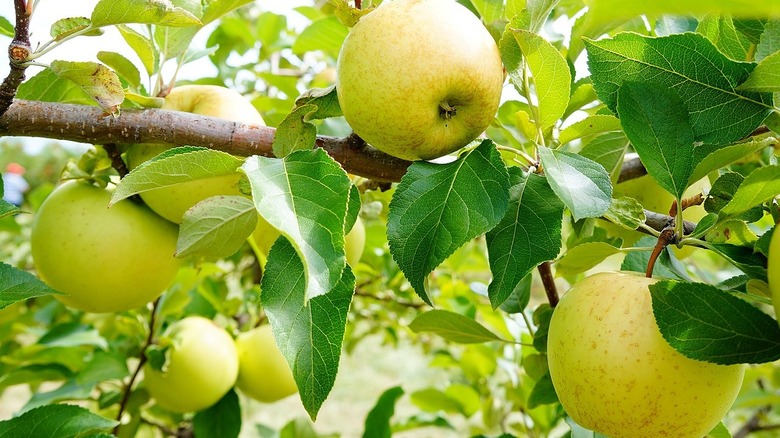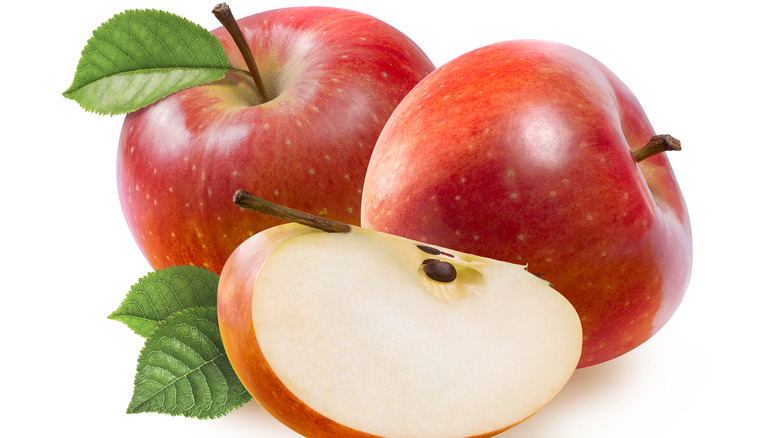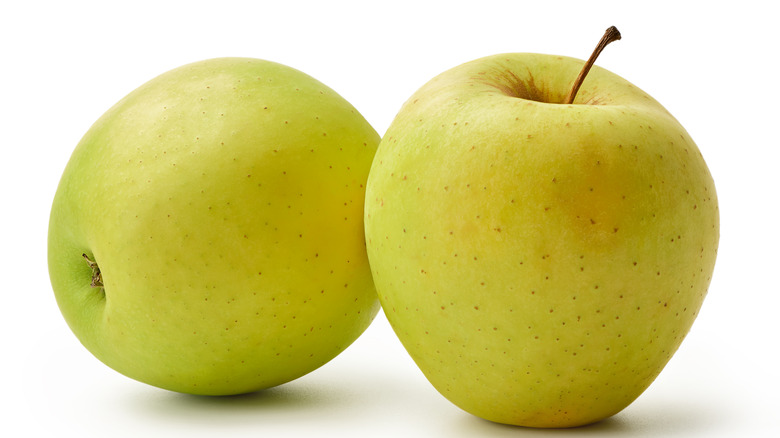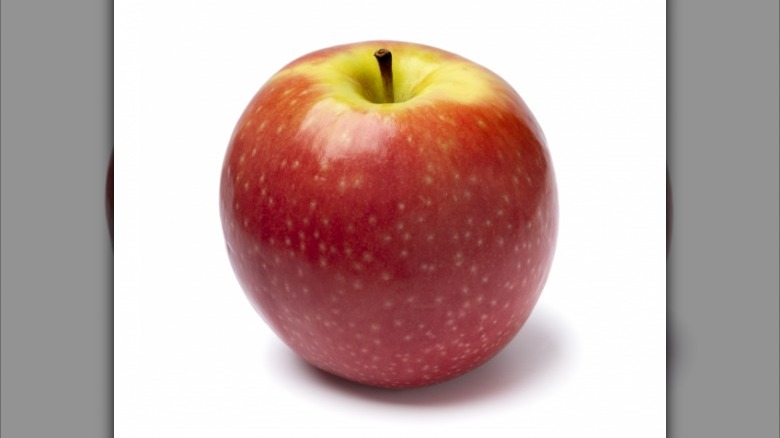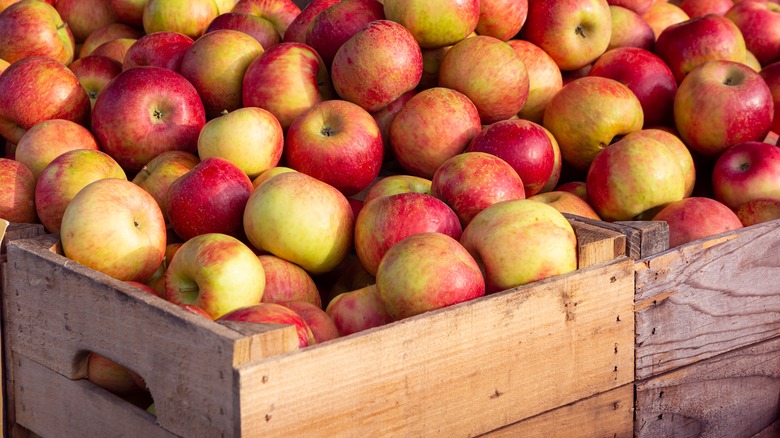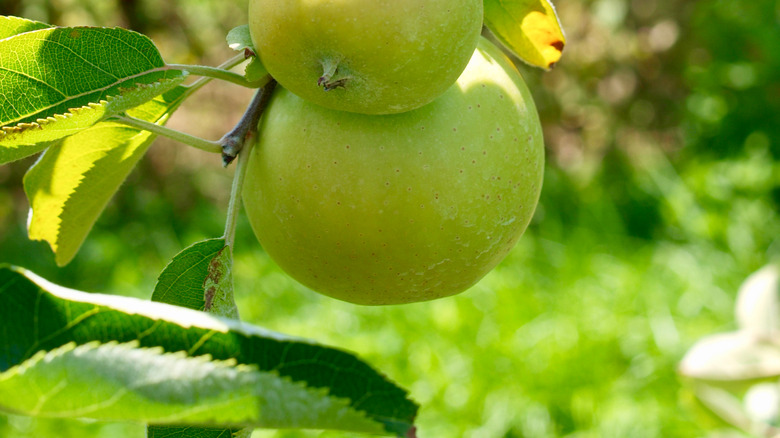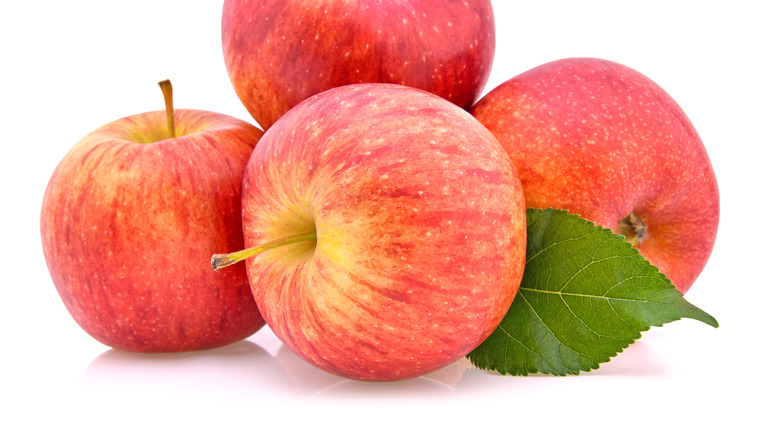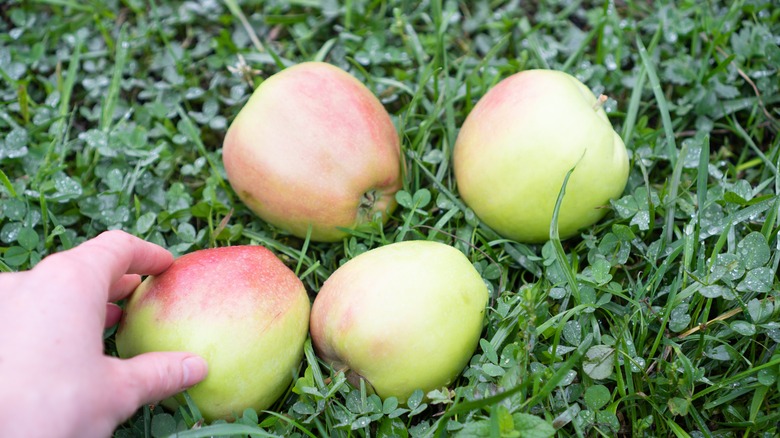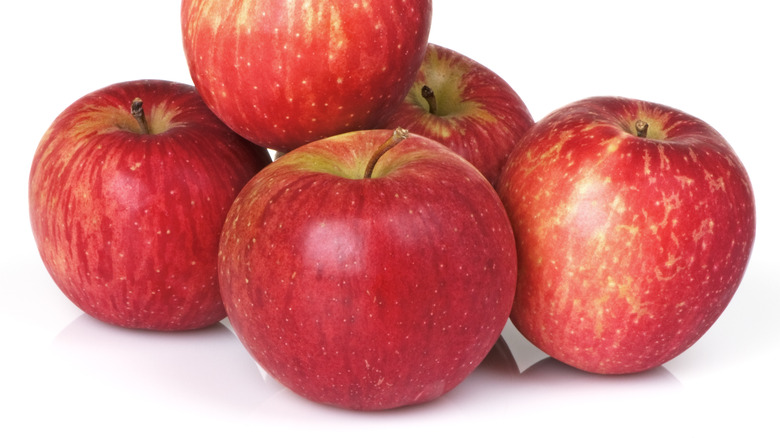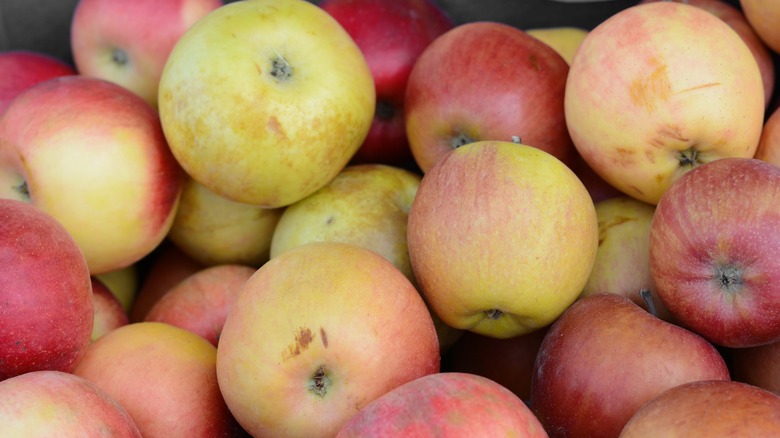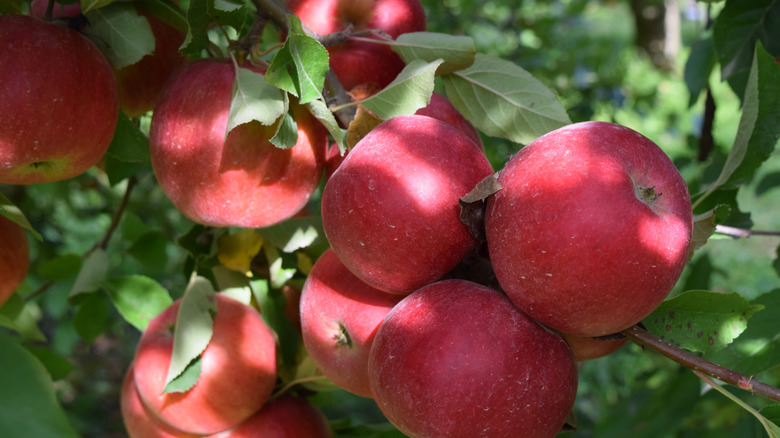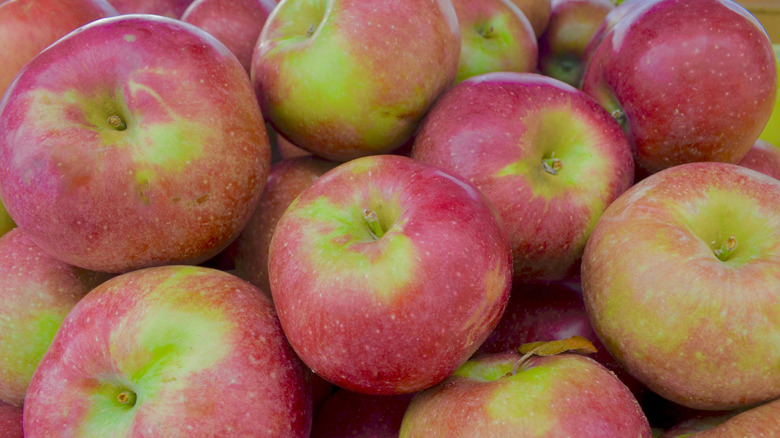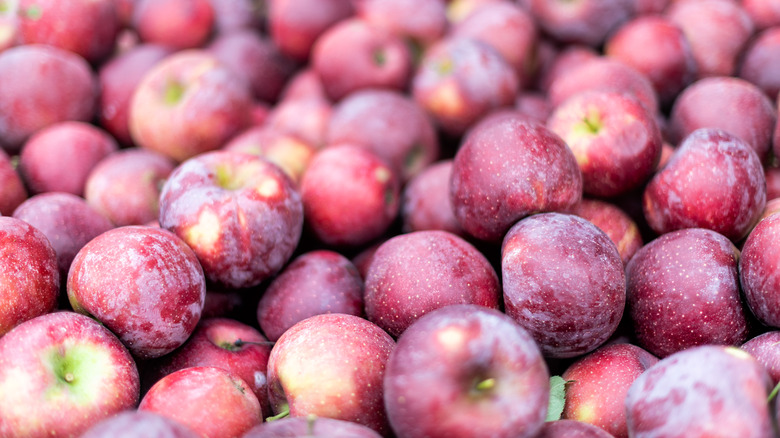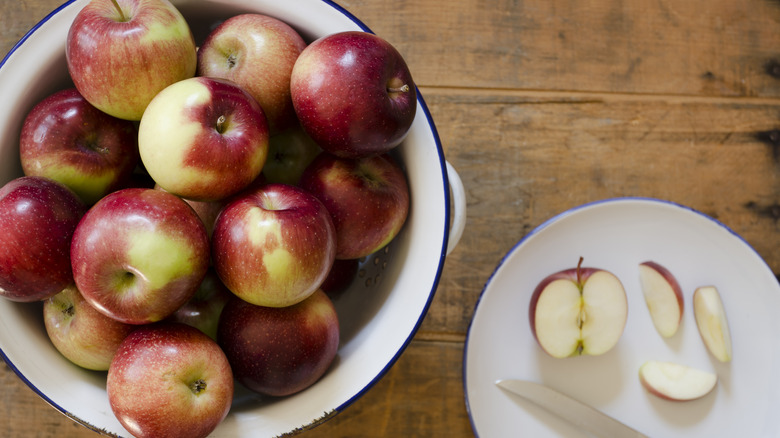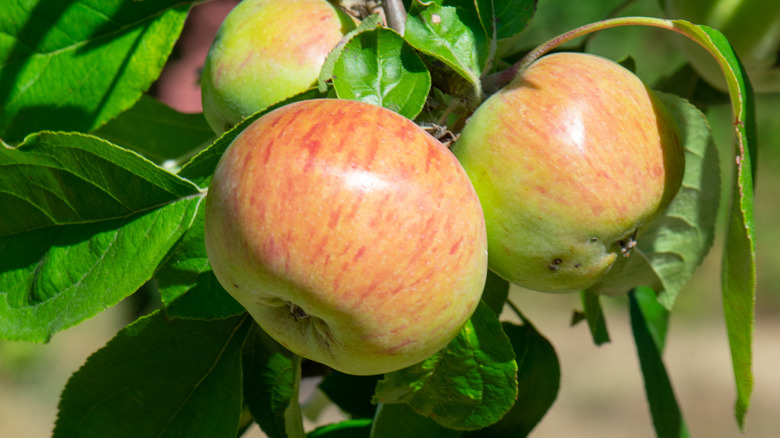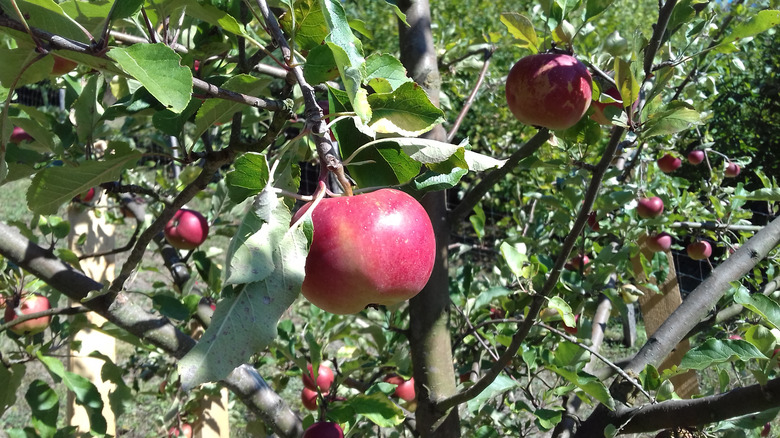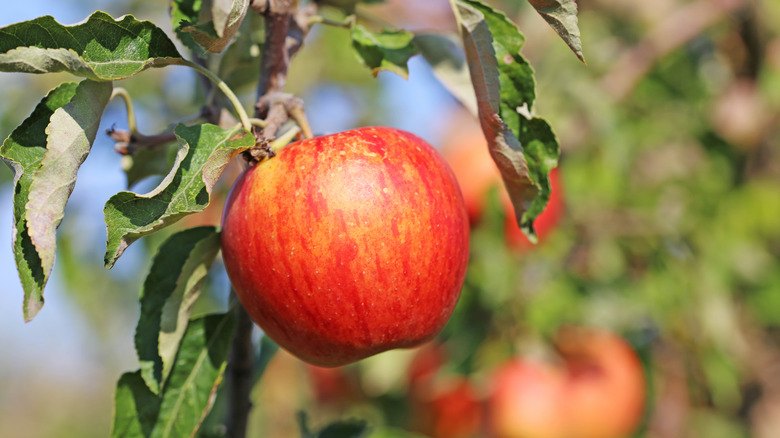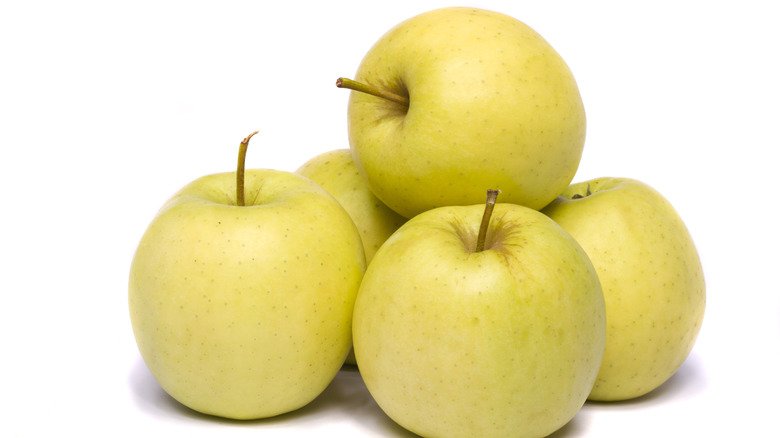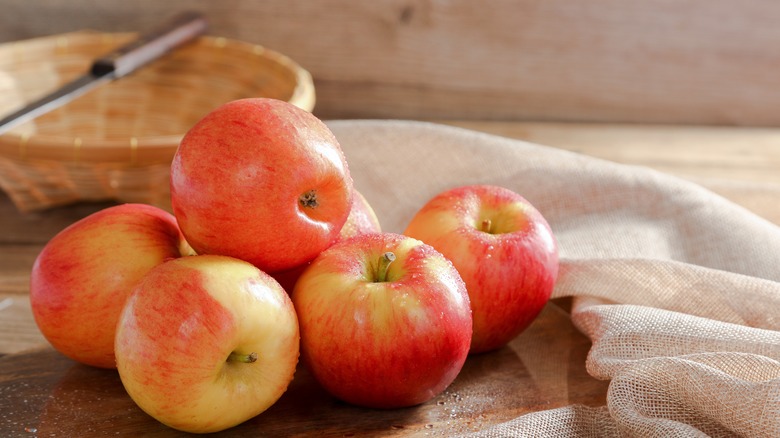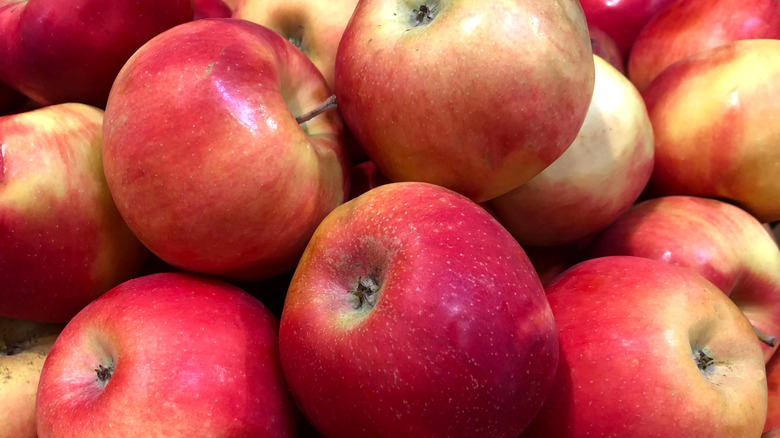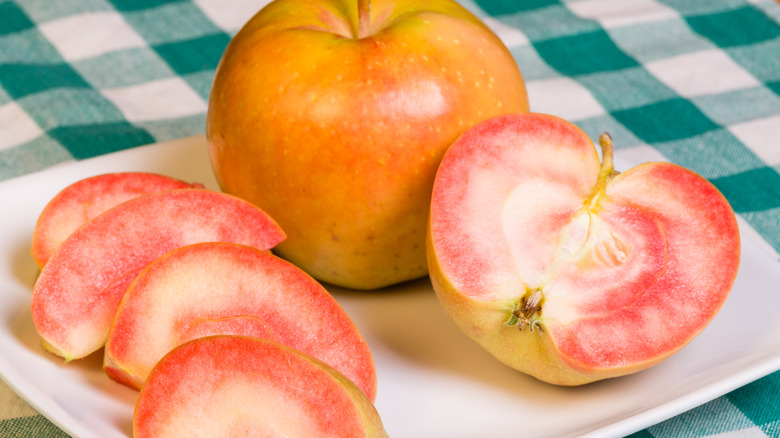The Absolute Best Apples For Baking
Finding the perfect apple to bake with can be a challenge and requires you to know a little bit about the characteristics of each variety. The ideal baking apple has a good taste and a good texture. While you may see some recipes ask for a mix of sweet apples, like Macouns or Empires, and tart apples, like Granny Smiths, you will see that all baking recipes require robust, sturdy apple varieties that don't get mushy when they're cooked. The apple slices should retain their shape when you bite into them rather than breaking down into an applesauce-like consistency.
There are just as many apples you should bake with as apples that you should stick to strictly snacking on or juicing. Some of the worst apples you can bake with include the plasticky Red Delicious and mealy McIntosh, which disintegrate when baked. Instead, try some of these varieties in your next apple dessert.
Cortland
Cortlands are the perfect stand-alone apple for pies, tarts, and muffins. The flesh of this cultivar is both sweet and tart in flavor, and it's easily recognized by its large size and juicy, soft consistency. These apples are usually dark red and have some streaks or blushes of green. Cortland apples are in season in the second half of September but can be found at most major grocery stores at any time of year.
Cortland apples are perfect for baking because of their diverse flavor profile and hardy texture. Although the Cortland has a similar softness to the McIntosh (which is expected, considering that the McIntosh is one of the Cortland's relatives), it has better baking utility. The Cortland variety also takes longer to brown compared to others, which is ideal for baking and fresh applications alike.
Granny Smith
The Granny Smith's unmistakable bright green hue, tart taste, and waxy peel make it one of the most recognizable apple varieties in most grocery stores. It's a quintessential baking apple because it retains its shape and offers a good contrast of tanginess and sweetness in everything from apple dumplings to apple tarts. In applications where the baker desires a sweet taste, the Granny Smith is usually paired with a sweeter cultivar, like a Winesap or Jonagold, for a more balanced tart flavor. Outside baking, the Granny Smith is often used as a garnish for salads or a sweetening element in recipes like roasted butternut squash soup.
Braeburn
The Braeburn apple originated in New Zealand but has made a big splash in American baking because of its crisp, zesty flavor and beautiful yellow and red hue. In addition, its taste has an undercurrent of citrus, which sets the Braeburn apart from other acidic or overtly sweet varieties. The Braeburn also has cinnamon and nutmeg notes, making this apple perfect for autumnal desserts. The Braeburn is harvested in September and October in North America, while fruits imported to the United States from Chile usually ripen in June.
Braeburn apples weigh almost ½ pound each, making them one of the largest varieties of apples used for baking. When baked, the Braeburn holds its shape and easily complements other flavors in the dish. If you can't find the Braeburn at your local orchard or grocery store, you can purchase some of its descendants, like Kanzi, Envy, or Jazz apples.
Winesap
Winesap apples are one of the smaller varieties of baking apples. Their skin is glossy, thick, and covered in crimson stripes. Their yellow flesh is dense, crisp, and crunchy — all qualities of a good eating apple. The Winesap's name is a nod to its wine-like flavor and connection to cideries which used the apple to produce complexly flavored cider in the 19th and 20th centuries.
Besides being an excellent snacking apple, the Winesap has many distinct qualities that make it good for baking. Since the apple's flesh is firm, it can easily hold up to baking, frying, and cooking.
Honeygold
Honeygold apples have the same yellow hue as a Golden Delicious but with a more pronounced honey flavor. This variety is a cross between the Golden Delicious and the Haralson, which resulted in a very cold-tolerant apple. Although its name is often confused with the Honeycrisp, these apples are two very distinct varieties.
Honeygold apples can be used as a substitute in recipes for the Golden Delicious. The flavor of the Honeygold is slightly sweeter and less complex, with a crunchier texture. The apple's flavor pairs well with cinnamon, nutmeg, honey, and caramel. It's great for pies, tarts, or dumplings.
[Image by Jiaqian AirplaneFan via Wikimedia Commons | Cropped and scaled | CC BY 3.0]
Jonathan
The Jonathan apple is endemic to the northeastern United States. These apples are considered heirloom varieties, meaning that the variety has been passed down from generation to generation rather than being commercially bred. As a result, the Jonathan is often hard to find.
Jonathan apples are very juicy with soft yet crisp flesh. It's not an especially large apple; most are taller than round. This variety is very aromatic and has a slight acidity to it. While this apple can be baked, it should be supplemented with other, sturdier varieties like Braeburns, Honeygold, Golden Delicious, or Granny Smiths for a less mushy texture.
Golden Delicious
Golden Delicious apples are characteristically yellow but can have some green or pale pink blush patches. Tiny dots, called lenticels, cover the surface of the apple. Its skin is soft and easy to puncture. The flesh of the apple itself is juicy, mildly sweet, and ivory in color.
The most common tasting notes associated with Golden Delicious apples are sugary, honey-like, aromatic, and floral. Like Cortland apples, the flesh of the Golden Delicious is slow to brown, making it a good choice for both eating and baking. With its natural sweetness, the Golden Delicious is a perfect addition to bakes like pies, bread, and cakes.
Pink Lady
The Pink Lady apple is a very acidic variety. The apple gets its flavor from its parents, the Golden Delicious and an Australian red apple called the Lady Williams. Its taste is described as very refreshing yet distinctively zesty and bold in flavor. This means you may have to pair it with other sugary apples for the desired taste in your apple pie or apple cinnamon muffins.
The Pink Lady has one of the longest growing seasons of any apple cultivar at around 200 days, meaning you can generally find these apples in grocery stores between October and July.
Honeycrisp
Honeycrisp apples, also known as Honeycrunch, have a balanced, sweet taste and juicy, snappy texture. The cream-colored flesh is very moist and perfect for mixing with drier apples for pies and cakes. Despite its moisture, the Honeycrisp's texture holds inside apple dumplings.
The one downside to purchasing these apples is their cost, and there's a reason Honeycrisps are so expensive. They have thin skin that is easily punctured and tends to develop dark spots, limiting their ability to sell. Only about 60% of the Honeycrisp apples grown are sold on the market because of how finicky the fruit can be.
Mutsu
Mutsu, also sold under the moniker Crispin, are green apples with firm flesh. In its home country of Japan, the Mutsu is often called the "million-dollar apple" because of how well it lends itself to Japanese apple desserts. The fruit is decent-sized, averaging around 3 to 4 inches in diameter. It has a mild bite and underlying spiciness that lends well to baking pies. The flesh itself can range in color from ivory to white and holds up well to gentle cooking, stuffing, and eating out of your hand.
One of the best traits of the Mutsu apple is how well it stands storage; the fruits can stay fresh for three to six months after purchase in your refrigerator's crisper drawer.
Gala
Gala are red-colored, medium-sized apples that grow as wide as about 3 inches in diameter. This apple variety has thin skin and bruises easily; its color can range from orange-yellow early in the season to a darker red before harvest. The mild flavor of these apples should be combined with bolder varieties like Granny Smiths or Mutsus in pies, strudels, crisps, and crumbles. The cultivar's gentle taste can be used to highlight nutty flavors like almonds, walnuts, or pecans. The storage life of the Gala is average compared to other types of apples, at around one to three weeks in the refrigerator.
Northern Spy
Northern Spy apples are native to the northern regions of the United States as well as Southern Ontario. The apples are identified by their green skin with red stripes and white, fleshy, and crispy interior. The fruit is also comparatively large, making it a good eating and baking apple. Because the flesh of the Spy, as it's otherwise colloquially known, can be a bit mealy, it may require a slightly longer cooking time than other varieties.
The Northern Spy is rare in most grocery stores, but you may find some of its descendants, like the Red Spy, Spigold, and Novaspy, instead.
Haralson
Haralson apples are one of the oldest varieties of apples in the United States. For years after its introduction in Minnesota, the Haralson was the state's favorite apple — until the Honeycrisp came along and took the top spot. Haralson apples have a tart, firm, white flesh and a complex flavor. While many people use the Haralson for charcuterie boards and as an eating apple, it does have the perfect meaty texture for baking into an apple pie. Outside of baking, the acidic flavor of the Haralson makes it an excellent choice for cider and juice making. The Haralson can be harvested in October and is found chiefly in and around Minnesota.
Jonagold
The Jonagold is a cross between the Jonathan and the Golden Delicious. You'll find the same tartness and snappiness of the Golden Delicious with the color and acidity of the Jonathan, along with undertones of honey. The Jonagold also maintains the color of the Golden Delicious with some hues of red or green from the Jonathan side of the family. Jonagolds are characteristically large. This apple variety has a shorter season and is available in stores between September and January, which makes them a good winter treat for baking and eating. Try combining your Jonagold with a sweet Winesap or Macoun for a delicious apple strudel.
Idared
The Idared (a portmanteau of "Idaho" and "red") is easily recognized by its bright red color. It is perfect for baking because it holds its shape and has a very juicy texture. The flavor is a mild combination of sweet and tart.
Idareds are often used to make applesauce because the hue of the peel colors the applesauce pink. One of our favorite ways to cook Idareds is to make white wine-baked apples. While Braeburns are a common option for this recipe, the Idareds have a more complex flavor profile that lends itself well to the cardamom, cinnamon, and brown sugar called for in the recipe.
Macoun
Macoun (pronounced "Mack-ow-an") apples are popular for eating during the September harvest season. The sweet undertones, crispy skin, and mealy texture make this apple one of the best and most widely available varieties you can pick up from your local grocery store. In addition, the flavor of the Macoun has notes of strawberry and spices, which gives the apple its unique flavor profile. We recommend pairing the Macoun with floral and fruity ingredients like raisins, almonds, and walnuts.
The Macoun can range in size from medium to large and comes with varying hues of green and red. It is also easily identifiable for its boxy shape.
Rome
Rome apples, also called Red Rome and Rome Beauty, have thick, glossy, and red-hued skin with streaks of crimson. Some Rome apples are also covered in white lenticels. A bite or slice into this apple variety reveals a cream- to pale white-colored flesh. The inside of the apple is dense, crunchy, and floral in aroma.
Rome apples are ideal for cooking because the sweet flavor and floral smell become more pronounced. In addition, this type is excellent for making baked apples because it retains its shape after being cored, filled, and cooked. These robust apples can also be cubed and added to pancake batter or your favorite muffin recipe.
Empire
Empire apples have a glossy, maroon-colored peel. The inside of the apple is an unmistakable bright white and does not bruise easily, making it a good apple for children's lunch boxes and raw applications. The taste of the apple is based on the taste of its parent varieties, the Red Delicious and the McIntosh, and some describe it as being fruity with notes of elderflower, melon, and pineapple. Empires retain their shape and flavor during baking, which makes this apple a good choice for pies and tarts.
Around 60% of the apples exported by the state of New York are Empires, and it's one of the top 10 apples grown and eaten in the United States. Empires have the best flavor during the September through October harvesting period but are also available in grocery stores through the winter.
Gravenstein
Gravenstein, or "Gravs," is one of the first apple varieties to come to harvest in North America, often in stores and farmer's markets by August. One of the most popular regions for growing Gravs historically and in the present is California's Sonoma County. Because the apple has soft skin, the Gravenstein does not lend itself well to shipping. It is also more vulnerable to blight than most varieties and has to be grown in regions where the climate is very stable and temperate.
Despite its shortcomings, the Gravenstein is a delicious apple. The flesh is firm, floral, and perfect for crisps and cobblers.
Melrose
Melrose apples are juicy and tart and ripen between late September and early October. The apples are large and zingy in flavor, and their skin is yellow-green skin with hues of red. The Melrose's creamy flesh sharpens with age, meaning that these apples are best eaten after a couple of months in cold storage. Melrose apples have numerous applications, including baking, cooking, and sauces.
The Melrose apple is primarily tied to its homeland of Ohio, where it is the state's official apple. It's been overshadowed by other varieties like Golden Delicious, but Melrose remains a popular apple among local orchards in the state.
Baldwin
The Baldwin is one of New England's oldest apple varieties. It was popular until the early 1900s, and a significant freeze in 1934 killed around half of the region's Baldwin apple trees. The color of these apples is coppery, with shades of bright red mixed with green and dispersed white lenticels.
Baldwins are in the middle ground between sweet and tart. The cream-colored flesh retains its shape during baking, making it a popular choice for pies and tarts. This apple stores well and has a slightly later harvest than other types; Baldwins are in season between October and November.
Ginger Gold
The Ginger Gold looks much like the Golden Delicious, but don't be fooled. These apples are much smaller than the Golden Delicious and can develop a waxy layer and crimson blush if left on the tree to ripen. Like the Golden Delicious, the Ginger Gold has a crisp, crunchy consistency that pairs well with warming spices like cinnamon, nutmeg, and allspice.
With time, the apples develop a more spicy undertone and sweeter, milder flavor. Since Ginger Golds are easy to store, these apples are a good option for making desserts beyond the growing season. Unwashed Ginger Gold apples can last a few weeks in the crisper drawer of your refrigerator.
Jazz
The Jazz apple resembles the taste of a pear drop, a British confection made with artificial pear and banana flavors. This flavor is not found in the Jazz's parent plants, the Braeburn and the Gala, but it may be connected to the latter's Delicious relatives. The shape of the fruit is upright and elongated, like a Red Delicious, with hues of red and yellow across its peel.
The primary precaution bakers must take when working with Jazz apples is that their texture can be tough and dense. So, making a recipe like an apple pie may require you to pre-cook the fillings to ensure the apples are soft enough. The Jazz can be found in North American grocery stores in November or December.
Esopus Spitzenburg
Although its name might sound funny, there's nothing funny about the utility of the Esopus Spitzenburg. In fact, this apple was purportedly former president Thomas Jefferson's favorite variety. This apple faded into the background after the 19th century, but it has had some resurgence with specialty growers and home gardeners.
The flesh of the Esopus Spitzenburg is yellow and dense with a sharp, bright flavor profile. The flesh is firm and juicy with lemony notes, making this apple excellent for both eating and baking. We recommend using its complex flavors to bake an absolutely delicious apple pie if you can find it.
Pink Pearl
The Pink Pearl apple has a very unique interior and exterior color. The skin of the apples is tan with small white lenticels, while the interior of the apple is a unique, tie-dye-like color with ribs of crimson interspersed with a pale base. In addition, Pink Pearl apples are very aromatic and feature notes of grapefruit and raspberry.
The showstopping color of these apples makes them ideal for pies, scones, tarts, and any application showing how bright the apple's hues can be. They can also be cooked down to make pink applesauce or sorbet. Pink Pearl apples can be found sold by heirloom apple vendors on the West Coast of the United States.
